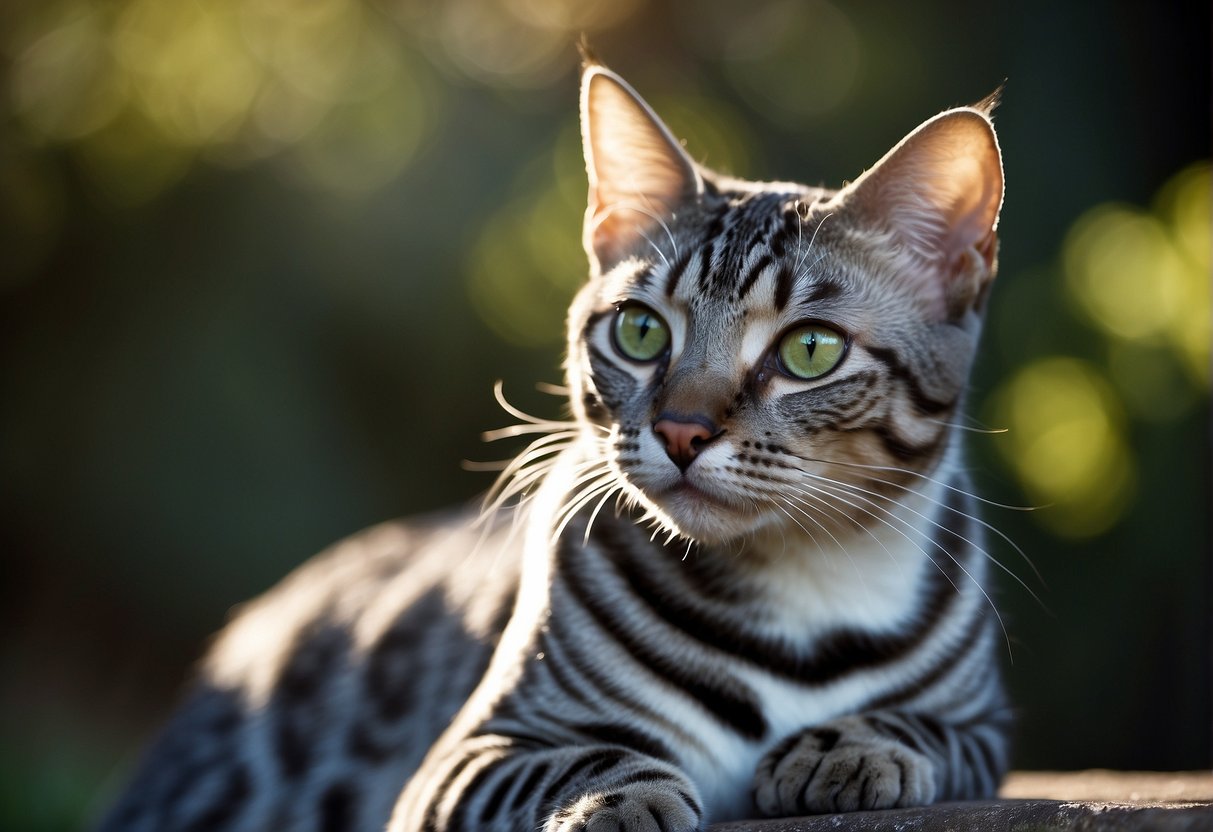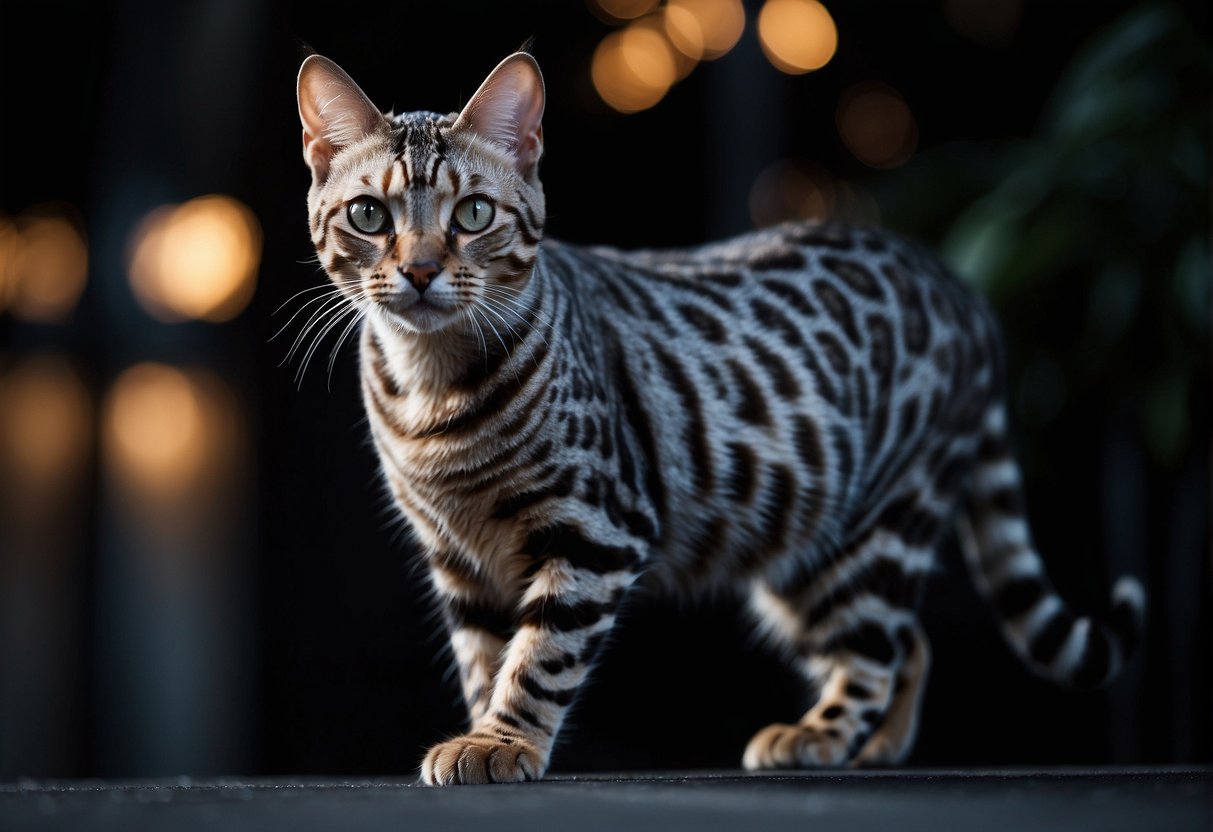Silver Bengal cats, known for their striking and unique coats, are a wonder in the world of domestic felines. As you delve deeper into the world of Bengals, you’ll find that while silver Bengals are not as pervasive as their brown counterparts, they are far from the rarest.
They are, however, unique not only in appearance but also in temperament. Renowned for their curious and intelligent nature, these cats offer enrichment and engagement to owners who cherish active involvement with their pets.

Understanding Silver Bengal Cats
Before venturing into the intricacies of Silver Bengal Cats, it’s important to understand what sets them apart in rarity and genetics.
The Rarity of Silver Bengal Cats in the Feline World
Imagine walking into a room and being greeted by a shimmering, almost magical cat. Silver Bengal Cats are exactly that—a blend of wild beauty and domestic charm. But are they rare? Yes, they are.
Their breathtaking silver coats are less commonly found than the traditional brown-spotted or marbled Bengal patterns. In the symphony of feline breeds, Silver Bengal Cats are like the rare violins that produce the most intriguing melodies.
Their silver coat, complemented by clear, sharp contrasting markings, makes them highly desirable and sometimes more challenging to encounter.
Genetics Behind Their Unique Appearance
Now, let’s talk about the secret behind their stunning appearance—the genetics. Silver Bengal Cats owe their gorgeous silver coats to a specific inhibitor gene. This gene acts like a magic wand, diluting the typical color to create that striking silver base you’re mesmerized by. As for the science:
- Inhibitor Gene: A dominant gene that prevents the deposition of pigment in the hairs, leading to the silver coloration.
- Dominant vs. Recessive: This dominant trait means that only one copy of the gene is needed for the effect to show in the coat.
Furthermore, the breed itself is a result of crossbreeding domestic cats with the wild Asian leopard cat, contributing to those bold and wild-looking markings. You might wonder if their personality is as wild as their ancestors’.
Although they have retained some of the vivid markings and physical resemblance, they are loving and suitable for your home just like any other domestic cat.
Breeding and Availability

When looking into the unique world of Silver Bengal cats, you’ll find that breeding practices, breeder selection, and the cat market play a crucial role in their availability. It’s important to understand these factors when considering if a Silver Bengal is the right companion for you.
Frequency in Breeding Programs
Silver Bengals are a result of meticulous breeding programs. They showcase a striking silver coat that requires a specific genetic combination to achieve.
Breeders, often members of The International Cat Association (TICA), work diligently to maintain the breed’s distinctive qualities, including their noted energy, personality, and intelligence. Their rarity can fluctuate with breeding trends, but Silver Bengals are not as commonly bred as other Bengal variants, making them a touch more exclusive.
Locating Reputable Breeders
When you’re on the hunt for a Silver Bengal, it’s vital to find a reputable breeder. A good starting point is checking with TICA or regional cat associations for a list of recognized breeders.
Reputable breeders prioritize the health, wellbeing, and genetics of their Bengals and are transparent about their breeding practices. They should willingly provide references and health guarantees for their kittens.
Market Availability and Value Assessment
The market availability of Silver Bengals can be moderate to low due to their specific breeding needs and rising popularity. Consequently, their price can often reflect their rarity, so be prepared for a significant investment.
Popularity affects availability, and as these cats gain more admirers, finding one might require patience and possibly a waitlist. Remember, a higher price doesn’t always equate to better quality; it’s the breeder’s ethics and the kitten’s health that are truly priceless.
Characteristics and Care of Silver Bengal Cats
Silver Bengal cats boast a remarkable coat that sets them apart—its silvery sheen and dark contrasting spots echo the wild ancestry of the Bengal breed. They generally weigh between 8 to 17 pounds and stand about 13 to 16 inches tall, presenting a sturdy and muscular form.
Grooming: Despite the luxurious appearance, your silver Bengal’s coat is surprisingly low maintenance. A weekly brushing will suffice to keep their coat gleaming and reduce shedding. These cats often enjoy the attention that comes with grooming, making it a bonding experience for both of you.
Temperament: Silver Bengals are known for their lively and intelligent nature. They are playful and require ample stimulation—think of interactive toys and engaging play. Be prepared for their energetic antics; there’s never a dull moment with these felines!
Health Problems and Lifespan: Generally, Bengals are a hardy breed, but monitoring for hereditary health issues like hypertrophic cardiomyopathy is wise. Regular vet check-ups will help catch any health concerns early. With proper care, your silver Bengal can enjoy a lifespan of 10 to 16 years.
Size and Weight: Your silver Bengal will be sleek and muscular. Ensure a balanced diet to maintain their weight, as obesity can lead to additional health concerns.

My name is James, and welcome to FAQCats!
Along with our team of cat owners, expert pet enthusiasts, and pet professionals, we aim to write engaging helpful, engaging content about cats. At FAQCats we strive to provide content that’s accurate and fun to read. Our team writes about everything related to cats; even the most complex of topics. Through extensive research and caring for our own fur-pals, we’re able to provide something cat owners worldwide will love. Have a look around, and leave us feedback anytime!

